Our Thailand Tour: Elephants, Tigers, Temples and Factories
With some thoughts on Buddhism and the Tennessee walking elephant
The symbol of the elephant is everywhere in Thailand, though there are far fewer of the animals now that teak logging is prohibited. Elephants could log an old-growth forest with much less damage than machinery. They would work their way between the trees and carry out logs, so there was no need to cut logging roads.
Two elephants greeted our tour group at "Elephant Kingdom," an adult and a little one, both waving "hello" with their trunks. Half a dozen were brought out for us to see and ride. The animals seemed affectionate toward their handlers - mahouts - and the tourists.
We were all invited to ride bareback, like a mahout. I held back at first, but after seeing a chunky fellow traveler claw his way onto the back of an adult elephant, I figured I could do it, too.
On a signal from his mahout, my elephant raised his right front leg, forming a step for my right foot. Pushing off on that foot while gripping the beast's ear with one hand and a fold of thick skin with the other, I hoisted myself nearly onto his back and scrambled the rest of the way up. Then I was told to shift forward onto his neck, both legs bent, with a knee beside either ear.
I spoke the word for "forward", and the animal began a slow walk around the field, jolting me to one side with each step. Even bracing with both hands, it took some effort to stay mounted.
Kae volunteered to ride the baby elephant, climbing onto his back with some help from the mahout. She had to ride on his back, as the youngster's neck was not yet strong enough to support a rider.
Later, most of our group took an optional elephant ride in a howdah, an open carriage strapped to the elephant's back. Our elephants walked in file along a steep hillside trail. It was the same jolting ride, just a little more secure since there were more handholds.
The ride was planned to last an hour, but the elephants were suffering in the intense heat. Ours took some water from a trailside tank to spray himself, cooling our legs as well. After thirty minutes, the chief mahout called a halt. After we dismounted, he gave us a refund for the lost half-hour.
There's opportunity here for an enterprising mahout, if he could train a Tennessee walking elephant. Teach the animal to step with bent knee, or whatever those horses do to give a smooth ride, and your elephant would be in constant demand.
We were invited to make the elephants a snack, rolling various ingredients into a ball to be carried on a banana leaf. The little one sneaked into the kitchen to steal some food and had to be shooed out by his mahout.
Each of us held out his snack to an elephant, who picked it up gently with his trunk. We also fed bananas, which they ate skin and all.
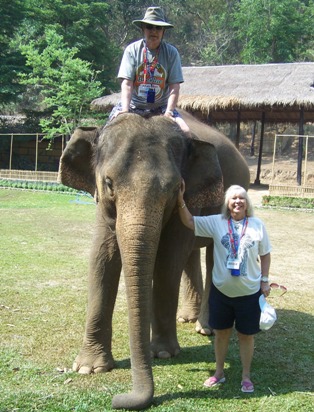
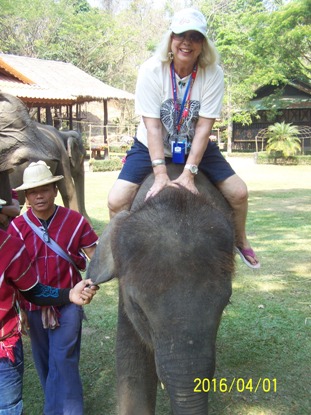
Left: Bob riding. Shadow on face obscures confident smile (NOT).
Right: Kae riding the "baby"
After the Elephant Kingdom, many of us took an optional trip to pet tigers. I had heard of this "attraction" and didn't think much of it, but our in-laws recommended it highly and Kae wanted to go. After paying fees and signing long waivers, we were let into an arcade of cages, where a handler would let us into a cage with one or two adult tigers for our photo opportunity.
Our two tigers were lying on their sides on the concrete walk, head to head, panting from the heat. We were told to stay far away from the tigers' faces, and to each take a seat behind one, where we could pet him or her on the butt. The handler took this picture with our camera. Then he motioned to pick up the tiger's tail for another shot. I don't think anyone actually pulled the tiger's tail. A playful nip from one of these beasts could take your head off.
Released from our cage, we walked around the arcade looking at other tigers. There was a newborn, the size of a large dog, in an air-conditioned glass enclosure. He looked a little dazed at us tourists, and soon moved to an inner door, waiting for his handler to let him into a back room.
The best photo op of all, unplanned, came after we left the arcade and were waiting for the rest of the group to finish. The handlers let several tigers into their swimming pool to cool off. There was a stream of water falling from an elevated spigot, and one tiger started to drink from it, just like our Juliette does at the bathroom sink. Then one handler brought out a tiger-sized version of a familiar cat toy and began to swing it back and forth over their heads. I got a picture of one tiger leaping up out of the pool to catch the toy.
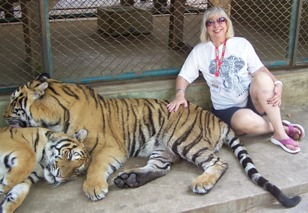

Left: Kae petting tiger Right: Newborn tiger
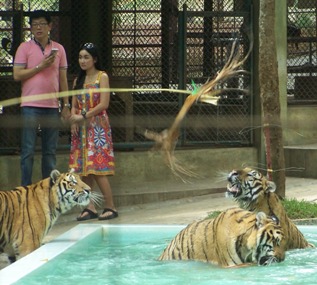

Left: Handler swings "Da Bird"
Right: Missed!
A traveler in Thailand is never far from one of the 300-odd Buddhist temples, and those on a guided tour visit them daily. Etiquette is a little stricter in temples than in European cathedrals: visitors must cover their knees as well as their shoulders. Most of the ladies eventually started wearing Elephant Pants - loose, baggy pants of light cotton fabric printed with an elephant design. Guys could work their Bermudas down at the waist to reach an acceptable length, or else buy a pair of extra-long shorts like I did. {With my long Shorts I now have a "temple garment", like a good Mormon.}
Buddhist culture infuses the country. The visitor learns to Wai his hellos, goodbyes and thank-yous: a slight bow of the head over hands joined in the prayer position. Certain Thai words that go along with this, but "Hello" or "Thank you" in English is understood. The gesture always seems to bring a smile.
As the wais suggest, Thais exhibit some of the virtues extolled by the Buddha: calmness, kindness, a reluctance to anger, and respect toward the visitor and each other.
Buddha figures are everywhere. Not the obese, laughing Buddha of Chinese restaurants, but a slim figure sitting erect in cross-legged posture, hands on his lap, with a slight smile. A spike on his head symbolizes his royal ancestry.


Left: Gallery of Buddha figures at Wat Po, main temple of Bangkok
Right: Buddha figures in ruins of Ayutthaya, a former capitol of Thailand
Mixed with the Buddha figures are occasional Hindu shrines, with food offerings. At the corner of every house lot is a small shrine, like a minature temple, dedicated to the spirits of the land, and another one for the family ancestors, both with the most recent offerings.
As a Unitarian-Buddhist, I kept wondering whether I was on the same page with these people. I accept the basic tenets of Buddhism as I understand them, leaving out the concept of reincarnation. But the offerings, the spirit houses and the talk about gaining merit seemed alien.
Our guide "Otto" frequently pointed out the Hindu, Animist and Taoist influences mixed in with Buddhism. Like many Thai men, Otto had been a monk for short periods in his life. Standing in the courtyard of the mountain temple above Chiang Mai, he remarked that all the images, stupas, good luck charms and the like were extraneous to a very simple teaching. "All this is just personal belief, superstition," he said, with a sweep of his hand. "Do the good thing, don't do the bad thing; that is all". He didn't mind the beliefs and practices imported from other religions. "Buddhism is a philosophy," he said, and could coexist with any religion.
At the last temple of our tour, on a mountain top overlooking Chiang Mai, I took a few minutes to meditate in a gallery corner, using a rolled-up sweatshirt as a cushion. Kae waited for me outside. She had never liked me calling myself a Buddhist. "Unitarian" she understood, but "Buddhist" sounded foreign and strange. But Otto's talks must have warmed her to the subject. She wanted to take the three walks around the temple that were suggested as a meditation, and so we did.
I left her at the incline railway stop, while I took the 290 steps down to street level for some exercise. These were another suggested meditation - you were supposed to concentrate on counting your steps. But with only ten minutes before the tour group's meeting time, I skipped counting and followed the Zen axiom, "When walking, pay attention to your feet."

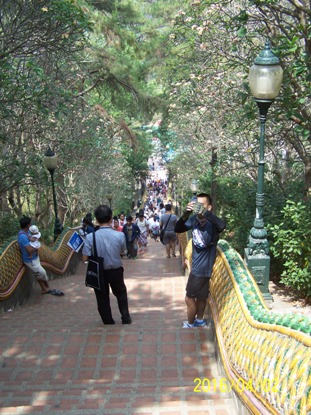
Left: Kae and Bob (in temple shorts) at side entrance to mountain temple Wat Phrathad Doi Suthep. overlooking Chiang Mai
Right: The 290 steps down from the temple
Reading about Thailand before our trip, I was amazed at the unemployment rate: less than 1%. And it's been below 1% for ten years or more. They have one advantage that the U.S. has lost: Thais manufacture a wide range of consumer goods, even automobiles, providing many manufacturing jobs. About half the workers are employed in agriculture; rice and a range of other crops are grown, both for domestic use and export. The irrigated paddies can produce three or even four crops of rice a year.
Touring the country, we noticed a general prosperity, though not great wealth. Everyone seemed to have work, food and a place to stay. We saw many busy shops, factories and warehouses here and there, and a countryside full of rice fields in every stage of cultivation. Automobile traffic in Bangkok was intense, but there were a great many motor scooters and bicycles mixed in.
In our shopping walks around Bangkok, I saw only one beggar. At home, there seems to be one at every freeway ramp. Bangkok has many, of course; there's a significant number of homeless, and even a soup kitchen. But if my internet search can be believed, that's the only soup kitchen in a city of six million. My home county, population 500,000, has two.
The downsides were nearly invisible, but we knew about them. The country was under military rule. Though Thailand changed from a monarchy to a crowned republic in 1932, it has had 17 different constitutions, and the 18th is being hammered out. In a general atmosphere of freedom, it is still a crime to criticize or disrepect the royal family, and this law has been extended to cover the military junta. There is a serious problem of human trafficing, and of outright slavery in the fishing industry. Hundreds were arrested in a recent crackdown.
An ongoing discussion in the Bangkok Post suggests that Thai industry is threatened by cheap Chinese imports. Many comments warned readers not to let their country go the same way as the U.S.
In spite of all that, a visitor sees mainly prosperity and friendliness - the wais and the smiles.
Comments
April 29
Hi Bob, Oh what fond memories! Thank you so much for sharing. We are still trying to sort out our pictures as we have far too many. Your blog was very informative and I enjoyed seeing Thailand from your perspective. Best regards to Kae.
- Jean Leider
Andover, MA
Post a comment...
All comments are moderated. I may answer flame mail directly, but will not post it unless it makes a good point.
References
Revisions to this post:
Blogging Without Blogware
Keeping a web log the old hard way
When I started this blog, I expected to use one of the popular online blogging platforms or some inexpensive blogging program. After a trying a few of each, I got fed up. None of the services or programs would let me just format a page, or even select colors and backgrounds freely. I was always invited to choose from a selection of templates, sometimes a very large selection. But never saw a template I really liked, nor one much like any of the blogs I admire.
Many bloggers are happy with one of these tools, and some excellent blogs are being published with them. Why am I so hard to please?
In thirty years of writing software, I’ve grown impatient with other people’s programs, particularly ones that seem to hold your hands and force you to do everything a particular way. Many come with their own vocabulary because the authors dreamed up cutesy names for familiar functions and structures.
I’m also suspicious of unneeded complexity, such as online databases for storing blog posts and comments. Databases are handy for things that change frequently. But blog posts and comments are pretty static, unless you're a prolific rewriter. Why bother storing and retrieving them?
After trying a few blogging services and tools, I went back to the same solution I've used for other kinds of websites in the past: coding directly in HTML. This is how everyone worked in the early days of the internet: code a page in a plain-text editor, open it in a browser to check, make changes, repeat.
HTML - Hypertext Markup Language - also provides the protocol by which computers communicate on the internet. It's been called "the glue that holds the internet together." HTML has stayed backward compatible over the years, of necessity, and is unlikely to be replaced anytime soon. The language itself provides all the functionality needed to display web pages.
(To see what HTML looks like, use the "view page source" function in your browser. In Firefox, for instance, right-click and select it from the popup menu. You'll see the words of this page interspersed with code words enclosed in angle brackets.)
In case you're curious, I'll describe below how I set up a web page to provide the usual functions of a blogging platform. But let me not lead you into frustration - don't try this approach unless you've done some coding in a computer language or have a high tolerance for intricate detail.
The main page of a blog needs a header with some graphics, a central column with posts stacked so the newest one appears at the top, and at least one side column with an archive of older posts. This can all go into one HTML file, which displays as a web page.
Some blogs seem to scroll down forever, but they can also take forever to load in your browser. I chop mine after 4 or 5 posts, one month's worth, and move the old posts to the archive. The archive is a collection of older versions of the main page, with any associated pictures, organized into folders by year and month.
The "Post a comment" link of each post brings up an email window. It sends the user's comments to a special email address, keyed to the position of the post in the main page. All these emails are relayed to the same final address, but I can make sure which post the sender is commenting on by checking the "To" field of the message.
A database might be handy for the comments. But I have to read each one anyway in order to moderate it, so at that time I can cut/paste it into a revised copy of the main page.
In the right-hand column I provide an email link to sign up for email updates, plus another link to sign up for an RSS feed. The code for the feed involves another markup language, XML. I found a simple template on the internet which I could modify: http://www.wikihow.com/Sample/XML-File-for-RSS-Feed.
In the future, I may add some of the social media links, such as Twitter, Share or Facebook.
Having built my own blogging platform, I was able to design the page freely within the limits of HTML. I borrowed a dark green color I admire from the Archdruid Report, by looking at the page source and copying the hexadecimal color code. For a background color, I wrote the hex code for a light gray, and then tweaked the green value a couple of points. Voila -- druid green and elfin grey!
One feature I wasn't able to create was the lozenge-shaped backgrounds used for columns in some popular blogs. HTML columns always come out as rectangles with sharp corners. As time permits, I'll see if I can fake it using bitmap images for the rounded corners.
To set up the "E" icon that appears in tabs and bookmarks beside the blog name, I created a bitmap file in MS Paint, saved it in PNG format, then converted it to "icon" format using a free program available at http://www.favicongenerator.com/. I added a line of html in the header of the web page to publish it.
Just to be clear, all of this has to be "hosted" on the internet by a service provider. I log on my provider's website, start up the file manager, and upload all the necessary files. (And a few more, every time I add a post or publish some readers' comments.) I pay an annual fee for hosting, another for keeping the domain name registered. The total bill for publishing Eclectications comes to about $5/month.
I use the bare minimum of tools, a plain text editor (Textpad) and a browser (Firefox.) There are myriad tools available for building websites, including many WYSIWYG editors ("What You See is What You Get") that will turn a formatted page of text into a valid html file.
My problem with tools in general is that once you start with a tool, all your work has to be done through the same tool. Typically it will slam all your HTML into a single block of text without line feeds or spaces, so you can't read it, let alone edit it, outside the tool.
The trouble with WYSIWYG is what you get but don't see: reams of unneeded code that you wouldn't have generated on your own -- a problem common to most code generator tools. One of my colleagues used a code generator for a first cut at each new program, then spent significant time "taking out the garbage" to clean up his code.
As soon as I started blogging, offers came in to help me find advertisements to host on my blog. No thanks! Advertising is the most annoying feature of the internet today. I don't want it cluttering up my blog posts.
If you're comfortable with coding and planning to start a blog, you might try my approach. I considered providing some templates, but there's no need. My page source is available for anyone who wants to read it. As the midget boxer's coach told him before the final round, "You know what to do, Shorty!"
Comments
Post a comment...
All comments are moderated. I may answer flame mail directly, but will not post it unless it makes a good point.
References
(Selected from many online references on these topics)
Setting up an RSS feed:
http://www.wikihow.com/Sample/XML-File-for-RSS-Feed.
Creating and using a favicon:
http://www.dailyblogtips.com/how-to-create-a-favicon/
Favicon generator:
http://www.favicongenerator.com/
A Simple Guide to HTML:
http://www.simplehtmlguide.com/essential.php
Revisions to this post:
May 23, 2016: fixed a couple of typos.
Inching Toward Sustainability
A goal I thought I'd already achieved
I never worried about soil loss from our family's farmland until last fall. We were doing everything the Natural Resources Conservation Service (NRCS) recommended to protect the soil, or so I thought: no-till cultivation, grassed filter strips along the streams and grassed waterways where gulleys could form. Subsurface drainage tile gave the land some added protection against erosion.
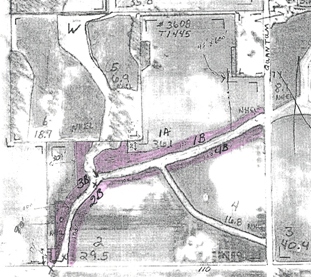
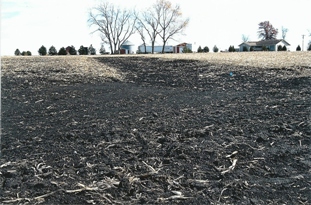
Left: Plan of filter strips along watercourses, 2000.
Right: Reseeding grassed waterway (buildings are on neighboring property.)
Photo by farm manager Gene Traetow.
Then I saw reports from two prominent
soil
scientists
that soil in the American midwest and Europe was eroding faster than it formed. The topsoil layer could disappear over most of these regions in less than a century.
I contacted the NRCS office near our land and asked for a new conservation plan for our property, which would provide an estimate of the rate of soil loss. We're waiting for the plan, to see whether we need additional anti-erosion measures.
When we get our soil loss estimate, we'll compare it to another estimate, a generally accepted figure for the rate of soil formation in the region. We can neither see or measure new soil forming, nor the old soil eroding (at the miniscule rate we've kept the process down to.) We're trying to balance two unknowns, using the best available estimates.
The NRCS technician recommended a cover crop, such as winter wheat or turnips, if we decided on additional protection. The crop would be planted in the spring and left on the ground after harvest to anchor the soil over winter.
It would also make the soil more permeable and loosen up areas compacted by tractor wheels. A leguminous cover crop could make the soil more fertile. Some cover crops would die off naturally over winter; others would have to be killed by mowing or herbicide in the spring.
She described seeing earthworms in some fields where cover crops and no-till cultivation were used. Earthworms in farm ground! As a sometime organic gardener, I considered these a sure indicator of healthy soil.
Later, searching through farmers' conversations on the internet, I learned that earthworms were common in no-tilled ground, even without cover crops. Some described the gradual appearance of worms after no-till cultivation began. Conventional no-till involves regular application of herbicides, but earthworms can tolerate many of these chemicals.
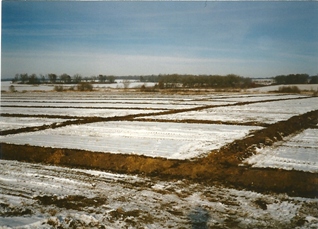
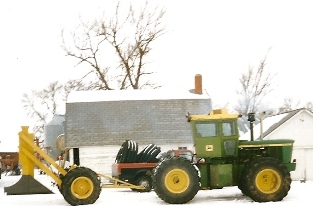
Left: Installing drainage tile, 1997.
Right: Trenching implement and wagonload of tiles.
Photos by the late Paul Woods, former farm manager.
Another measure that could reduce soil loss on our land is the newly developed "Prairie Strip"
system: planting ten per cent of a no-tilled field to narrow strips of native prairie grasses. But installing the strips on our property would require destroying the grassed waterways and filter strips already in place, then planting the strips -- an expensive process. And we are under contract with USDA to maintain those measures.
Several farmer organizations are promoting cover crops and additional conservation measures (references below.) One newsletter
article
suggests that a cover crop may provide more cost effective pest control on corn than using pest-resistant GMO varieties.
I sometimes read that midwestern farm soil has been drained of its natural fertility or reduced to "a sterile growing medium." But many farmers and farm families do all they can to take care of the land, within the constraints of farmstead economics. Not to mention the occasional innovator doing organic farming or permaculture.
When I first wrote about soil erosion a few months ago, I had helpful comments from organic farmers and permaculturists, trying to steer me toward their methods. But as a landowner who does not farm, I'm limited by what tenants and potential tenants are willing to do. Happily, our current tenants seem willing to plant a cover crop if we need it.
Readers may cringe at the implication that regular use of herbicides is "sustainable." In the longer run, it's not. But preserving the soil is fundamental to sustainability. Preserving a healthy, naturally fertile soil with the help of earthworms is even better. And if someday a prospective tenant approaches us with a plan to farm organically, we'll be open to it.
Our farm manager, Gene Traetow, thinks turnips would be the best choice for a cover crop. Their deep roots are especially good at loosening compacted soil.
Gene is a real estate agent and farm manager. He worked closely with NRCS and ASCS (Agricultural Stabilization and Conservation Service) in 2000-2001 to get our filter strips and grassed waterways installed. He's keeping an eye on one place on our land where a gulley may form, if drainage on the adjacent county road isn't improved. We may need to install another waterway there.
So we're waiting now for the NRCS conservation plan. If a cover crop is needed, USDA may share the cost of planting it. Otherwise we may need to reduce the rent to compensate our tenant. Whether we plant cover crops or not, I'll be looking for earthworms the next time we visit our land.
Comments
May 25
Let's hope their figures and predictions apply to all lands, including mismanaged ones, and not just to land properly maintained and conserved. And consider that if the total amount of uneroded and tillable land decreases, your protected property will gain in both productivity and value.
George Meyer
Tampa
Post a comment...
All comments are moderated. I may answer flame mail directly, but will not post it unless it makes a good point.
References
Prof John Crawford, Univ of Sydney "What If the World’s Soil Runs Out?". Time magazine, December 14, 2012.
http://world.time.com/2012/12/14/what-if-the-worlds-soil-runs-out/
Prof Rick Cruse, "Soil Erosion in Iowa: How much is really happening?" ISU webinar April 2014
https://connect.extension.iastate.edu/p7sqo5f1v71/
Practical Farmers of Iowa
Midwest Cover Crops Council
Iowa Learning Farms
NRCS, "Agricultural Management Effects on Earthworm Populations"
http://www.nrcs.usda.gov/Internet/FSE_DOCUMENTS/nrcs142p2_053291.pdf
PFI Winter 2015 Newsletter, p. 8,
"Protecting Cash Crops: Cover Crops
or Genetically Engineered Traits?"
http://practicalfarmers.org/wp-content/uploads/2015/02/Winter-2015-Newsletter-Final_Web.pdf
Strips of Native Prairie Protect Farm Soil
Revisions to this post:
Going the Extra Mile
A novice kayaker pushes some limits
My right hand has almost stopped aching from last week's kayak trip. I had planned on paddling for ninety minutes or so, but kept going for three hours, caught out in stonger wind and chop than I expected.
A north wind was blowing about ten knots as I left my dock, giving me a boost as I headed south to the main canal, which led out into the Great Lagoon of the Ais.
We live on an island in the lagoon, near where the Ai village of Ulumay used to stand. It was somewhere in the Ulumay nature preserve, which bears one of the two or three place names that remain from the original Florida indians - the seventeen "lost tribes" who died out during the Spanish occupation.
The lagoon isn't named on today's maps. French pirates and Spanish colonists knew it as a lagoon, but some Anglo settler decided to call it the "Indian River," perhaps because of its outline on a map, Two or three miles wide and 150 long, it's narrow enough to be a river. Our local branch is labeled "Banana River."
I wore a wide brimmed hat, sunglasses, UV shirt, leather-faced gloves, long swim trunks, life jacket and plenty of sunscreen. After an in-situ melanoma, I take no chances with the sun. It may sound like a warm outfit, but in the steady breeze you always find on the lagoon, it's comfortable.
I felt wind in my face, channeled by a row of waterfront houses, as I paddled eastward in the main canal. Out in the lagoon there was a light chop from the northeast, pushed by the north wind. I headed north, following the daysailor's rule: go out against the wind, then let it help you on the return home.
There's always a chop on the lagoon, the only question is how strong. When I started kayaking, I chose a sea kayak, seventeen feet by two with a rudder. It holds its course better in wind and chop than a short boat. I can cruise at 4 mph in calm water, pretty fast for a human powered craft.
The boat came with a spray skirt to keep water from splashing into the cockpit, but I didn't have it along - I hadn't used it so far. It would probably be hot in the warm season, and I hadn't tried fitting it on the boat in the water, which could be a struggle.
A causeway to the north sheltered this stretch of water, so the waves had only a mile or so to build up. I knew I would see higher waves after I crossed under the causeway bridge. Paddling steadily in the shallow water, I could see dark patches of sea grass passing underneath, alternating with bare sand - a welcome sight.
So much sea grass has died in the lagoon in recent years, and the waters of our canal seem much dirtier than when we first moved in. Locals say in the 1950s you could look down from the causeway bridges and see the bottom. Not today.
I passed a familiar sailboat, moored in the same spot as long as I can remember. It had dragged its mooring months before, and was heeled over on a sandbar. The white topsides and blue hull looked clean, but the bottom was crusted with a thick black layer of barnacles. Abandoned? You never know. A boat or two washes up on causeway or shore with every big storm. Some stay there for years.
I paddled on past a park and boat ramp, approaching the low bridge near the middle to avoid fishing lines. A young girl was casting from the western bank. I waved and asked if she was getting any bites, but couldn't understand her reply.
The swell was strong under the bridge, channeled into the narrow gap. Out in the open, it lessened. I pushed on past the entrance to the barge canal, heading for a power line to the north. I had thought of taking the kayak this way to go fishing, further north in a restricted zone where no motorboats are allowed. But it would be a long pull.
Across the barge canal, the swell grew stronger. Now the waves had about five miles of "fetch" across open water to where I was paddling, a few hundred yards from the western shore. I had expected to reach some of the spoil islands near the central channel, but distances were longer than I remembered. The islands would be about a mile east of my course.
As I passed under the powerline, the wind was picking up - maybe fifteen knots - and the waves had grown to two feet or so, many breaking into whitecaps. I didn't want to turn and get in the trough. I might have been OK - there was a calmer patch between each batch of strong waves - but I didn't want to chance it. I figured I could reach Kars Park, on NASA property a mile or so further north, to rest and then turn around in a sheltered marina.
I aimed the prow toward the distant vehicle assembly building, taking a course that edged closer to shore but kept me at an angle to the oncoming waves. I couldn't see the park yet. I expected the waves to be worse as I got into shallower water, where more of them would break.
I decided to pay closer attention to the course ahead and stop looking at individual waves. Let the boat take care of them. She probably would, and if not, at least she would float. And so would I.
I'd read about the technique for getting back into an overturned kayak, and it sounded pretty acrobatic. My contingency plan was to stay with the boat and drift to a sandbar where I could stand up to get back in. Nobody gets "lost at sea" in the lagoon. Drowned, maybe, but not lost - you're bound to fetch up against a sandbar or shoreline before too long.
To that end, I had my paddle tethered to the boat, and wore a good fitting life jacket. In years of rowing and sailing on the lagoon, I never thought much about life jackets - just some gear you carried along - and I never wore one.
But when I started kayaking, I realized I'd have to wear the jacket to have any chance of using it in need. I actually did what the little safety cards on the jackets recommend: put it on and tried it out in a swimming pool. I first tried a handy-looking "fisherman's vest," and found it rode up over my nose in the water, no matter how I tightened it. I finally chose a pricey model from a marine store that fit snugly and stayed down.
I was wishing I had the spray skirt. If one of those waves washed over the boat, I'd have water in the cockpit, sloshing back and forth and make it harder to balance.
Even with a steady stroke, I was moving very slowly, almost still in the water. I pushed harder and scanned the shoreline for some sign of the park. Picking a new landmark, I angled a little more toward shore. As I moved into shallower water, the waves seemed to weaken.
The first sign of the park was a white building, a prefab or trailer, contrasting with the green shrubs and mangroves along the shore. Then I began to see a narrow line of sand, more of a cut bank than a beach. I thought I remembered a little marina in the park, but couldn't see any sign of it.
Suddenly a channel opened up - rows of markers and pilings leading into a dock beside a ramp. It had been hidden until I was almost aligned with it. I turned away from the wind - the swell was much lighter here - and headed in the channel. I wanted to get out of the boat and stretch my legs for awhile. From this distance, the ramp looked like sand.
No boats were out, but I saw a dark head near a clump of mangrove - a diver with no flag? More likely a manatee. Sure enough, a manatee tail-swirl grew on the water as the head disappeared. I steered a little to the left - "Just don't surface under me, Buddy!"
In the marina cove the water was dead calm. I edged up to the dock and held onto a stringer with one hand, pulling out my water bottle. I could see the ramp was concrete - no place to be pulling up my plastic boat. So I rested awhile by the dock.
And then I turned the boat with some long sweeping strokes and headed out the channel. I lowered the rudder for going downwind, then stroked rapidly toward the left as I seemed on track to graze a piling. Straightening up, I moved out along the centerline of the channel, then turned downwind just past a "slow zone" sign.
The trip south to the causeway seemed slower than I expected, though I was moving fast. Every few waves, I'd be surfing. In between, I was sailing as I paddled, the prow parting water like a power boat. I kept sawing on the rudder as the bigger waves waggled the prow, and had to discipline myself to pick one setting and hold it.
Once under the bridge, I turned shoreward into nearly calm water and laid down the paddle. My right hand was cramping up, and I flexed it for awhile to ease the stiffness.
It would be two miles or so home, but here the waves were mere ripples, and the north wind behind me made for easy paddling.
Would I be out in such conditions again? Yes, but with more care as to what I took along, and when and where I went. If I wanted to fish the motorless area, I'd start from Kars Park. And it was time to master the spray skirt.
Comments
Post a comment...
All comments are moderated. I may answer flame mail directly, but will not post it unless it makes a good point.
References
Florida Lost Tribes, Theodore Morris
Provisional gazeteer of Florida place-names of Indian origin, USGS, UF Smathers Library
Revisions to this post:
May 3: added references, fixed a typo.
First Day at the Soup Kitchen
During my programming career in the defense industry, I sometimes envied my lab tech wife and nurse-practitioner daughter. They knew that nearly everything they did from hour to hour through the day helped someone in a concrete way. All my workday efforts went to maintain and extend a military machine, bloated beyond any concept of "defense", whose net effect on the world for good or ill was debatable.
Having time on my hands in retirement, I decided to seek that missing feeling of usefulness by volunteering at a local "soup kitchen." Which is a misnomer, of course - who has time to make soup these days? But we have several Sharing Centers and the like in the county, two of which serve a free meal every day for needy people. I volunteered at the closest one, choosing a convenient weekday shift.
I arrived early next Thursday at the Sharing Center kitchen, where the staff and volunteers were preparing to serve a crowd of a hundred or more. Cook/manager "Joe" seemed to have all the help he could use already, but he found a job that needed doing.
I rolled plastic utensils in napkins for the next 90 minutes - did 200-300 sets, I think. "Mary" and "Bill", a couple from Merritt Island, were cutting slices from donated cakes and pies to fill dessert trays. The donors were generous. Our dessert trays would have looked tempting in a bakery window, and we had a large cooler jammed with left over cakes and pies.
Later, Bill and assistant cook "Larry" brought in a grocery cart full of donated bread - hamburger buns, french style loaves, every kind of specialty bread. They arranged them on large trays and painted the tops with melted butter. Each tray would be warmed in the oven before serving. Leftover bread went to tall shelves on either side of the dining room, where patrons could select loaves to take home.
In the kitchen, Mary prepared frozen lasagna rolls for the oven, pouring tomato sauce over them and sprinking Italian seasoning. Joe boiled hot dogs, while Larry mixed eight gallons of grape kool aid in a barrel-sized cooler. Ten minutes before serving time, he added two gallons of ice.
When serving began, I worked on the line, collecting "tickets" and pouring and serving plastic cups of kool aid. We served 104 that day, as well as the volunteers and staff. A hundred was typical for days early in the month; later on, there would be about 150 a day. We served from 11 a.m. to 1 p.m.
Every person who came for a meal had to register, if not already on the roll. Then he got a lunch ticket - a two-inch square of plywood with a number. Handing in the ticket at the serving window, he received a glass of kool aid, a large plate of food, a big bun or roll and a dessert of his choice, from whatever was on the current tray.
It was a plain, solid meal like you might get in an Army mess hall: a lasagne roll with a hot dog on the side, green beans, a choice of green salad or fruit coctail, and a slice of pie or cake. All condiments were at the serving window. Many of our patrons spread a little hot sauce over the pasta and beans.
An elderly black man spread ketchup over most of his plate and opened his bread to make a ketchup sandwich. Joe called him "Reverend Ketchup". He had greeted us all when he came to the window. He looked ready for the pulpit, in a dress shirt, tie and hat.
We only provided trays on request, so nearly everyone did a balancing act - bread on top of a full plate, dessert on top of the kool aid cup, utensils gripped by a free finger or in a pocket. Some managed to carry a loaf of bread as well.
Four of us formed the serving line. Mary and Bill prepared the hot food plates. "Susan", to my left, added the optional salad or fruit and handed each patron his plate and desert. Larry, the assistant cook, washed pots, pans and trays continuously as they were emptied. A ceiling rack held giant cookpots, like I hadn't seen since Ft. Bragg.
Many patrons called a "hello" to Joe or assistant cook Larry. Most thanked us servers as they picked up their plates, and we responded. One lady folder her hands in a blessing before taking her plate. Quite a few thanked us as they passed the kitchen, leaving the dining room.
About one patron in five looked ragged and may have been homeless. Most others were nicely dressed in casual clothes. There was a fair mix of black and white, men and women. Four mothers with small children or infants came in. One hispanic lady was shepherding her elderly mother through the line. There was a full range of ages from teens to elderly. One 60-ish black man came through carrying a supplemental oxygen bottle. He managed to carry everything without a tray.
One lady had jeweled nails; another got compliments on her large, sparkly earrings. There were probably some there who didn't really need a free meal, but no one could say, or say how many. Some put cash in the donation box beside the serving window. The sharing center stresses that "everyone is welcome."
Whenever something is offered for free, some people will take advantage. You can't screen them out without denying others who are really needy.
Not all freeloaders are poor. I remember a lunch seminar where a trust lawyer described how he could help us hide assets so as to qualify for Medicaid, if I or my wife outlived our long-term care insurance. We decided our savings and real estate would be adequate - and hoped we were right. Our own lawyer told us some of his clients had had the same idea, but changed their minds "once a couple of those $18,000 bills came through".
The kitchen bookkeeper, "Walley," said they had only a small group of "regular" patrons. Most of the people he registered only came in once or twice. Over a thousand had registered over the four months past.
Walley showed me his system. He used a combination of computer and paper records - the data on paper would eventually go into computer files. He seemed to have it all under control. I'd thought of offering computer help, but I'm not one to enhance or "fix" what ain't broke.
As serving ended, Joe himself was out in the dining room wiping down tables and walls. They had been wiped before we opened, as well. Both kitchen and dining room were clean enough to pass any inspection.
After closing, I took a small plate of lunch, no dessert, and ate in the volunteer dining room. I expected to talk with my coworkers, but they had already eaten, grabbing a bite here and there while serving. Joe and Larry were doing the final cleanup in the kitchen. I checked if they needed help, and confirmed I'd be there next Thursday.
Had I gotten that feeling of usefulness? I had concentrated on dipping kool aid, filling cups to the right level and keeping a few cups ahead. But it was a pleasant crew to work with, patrons were mostly friendly and grateful, and it felt good to have put in four hours of truly useful effort.
Comments
Post a comment...
All comments are moderated. I may answer flame mail directly, but will not post it unless it makes a good point.
References
Revisions to this post:
Previous Post:
Slumbering Champions